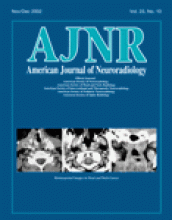Research ArticleBRAIN
Time-of-Flight MR Angiography of Carotid Artery Stenosis: Does a Flow Void Represent Severe Stenosis?
Paul J. Nederkoorn, Yolanda van der Graaf, Bert C. Eikelboom, Aad van der Lugt, Lambertus W. Bartels and Willem P.T.M. Mali
American Journal of Neuroradiology November 2002, 23 (10) 1779-1784;
Paul J. Nederkoorn
Yolanda van der Graaf
Bert C. Eikelboom
Aad van der Lugt
Lambertus W. Bartels

Submit a Response to This Article
Jump to comment:
No eLetters have been published for this article.
In this issue
Advertisement
Paul J. Nederkoorn, Yolanda van der Graaf, Bert C. Eikelboom, Aad van der Lugt, Lambertus W. Bartels, Willem P.T.M. Mali
Time-of-Flight MR Angiography of Carotid Artery Stenosis: Does a Flow Void Represent Severe Stenosis?
American Journal of Neuroradiology Nov 2002, 23 (10) 1779-1784;
Jump to section
Related Articles
- No related articles found.
Cited By...
- Prevalence and Outcomes of Symptomatic Intracranial Large Artery Stenoses and Occlusions in China: The Chinese Intracranial Atherosclerosis (CICAS) Study
- Geographic and Sex Difference in the Distribution of Intracranial Atherosclerosis in China
- Comparison of Carotid Plaque Ulcer Detection Using Contrast-Enhanced and Time-of-Flight MRA Techniques
- MR Angiography and Imaging for the Evaluation of Middle Cerebral Artery Atherosclerotic Disease
- Contrast-Enhanced MR Angiography Is Not More Accurate Than Unenhanced 2D Time-of-Flight MR Angiography for Determining >=70% Internal Carotid Artery Stenosis
- Measuring Carotid Stenosis on Contrast-Enhanced Magnetic Resonance Angiography: Diagnostic Performance and Reproducibility of 3 Different Methods
- Contrast-enhanced MR angiography for carotid disease: Diagnostic and potential clinical impact
This article has not yet been cited by articles in journals that are participating in Crossref Cited-by Linking.
More in this TOC Section
Similar Articles
Advertisement











